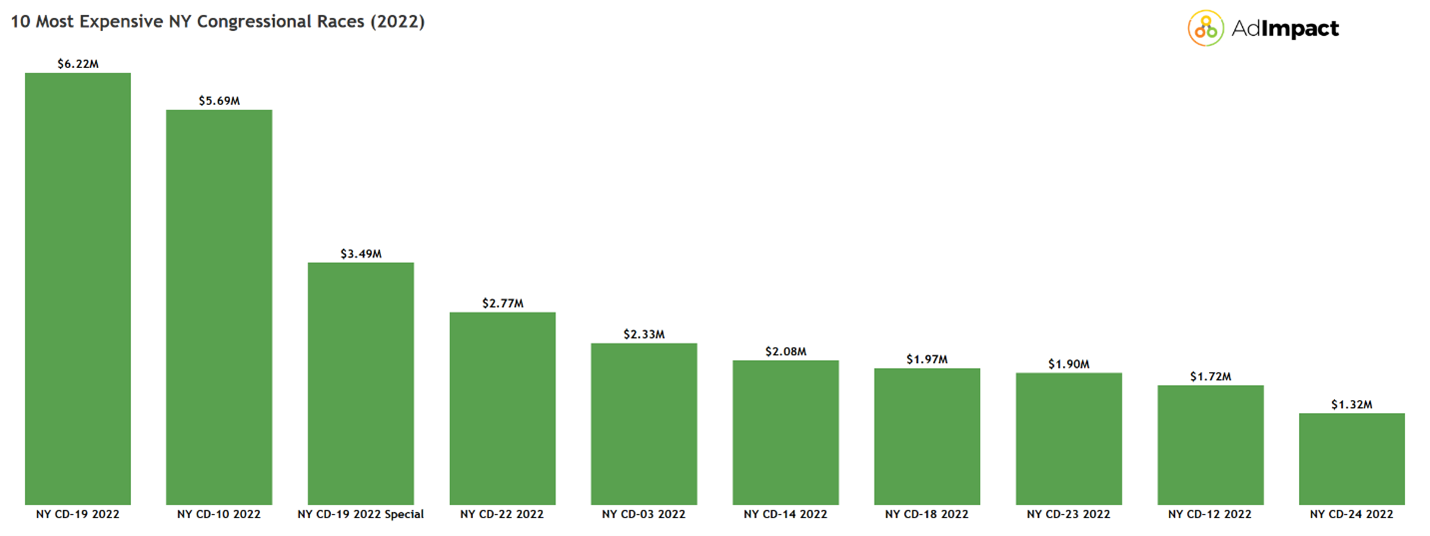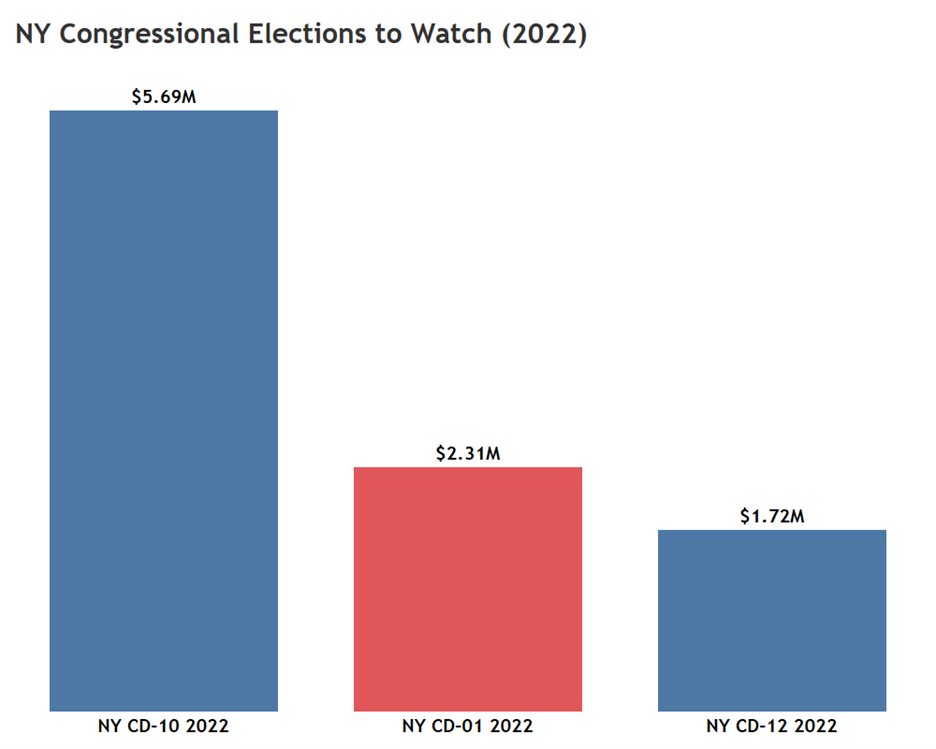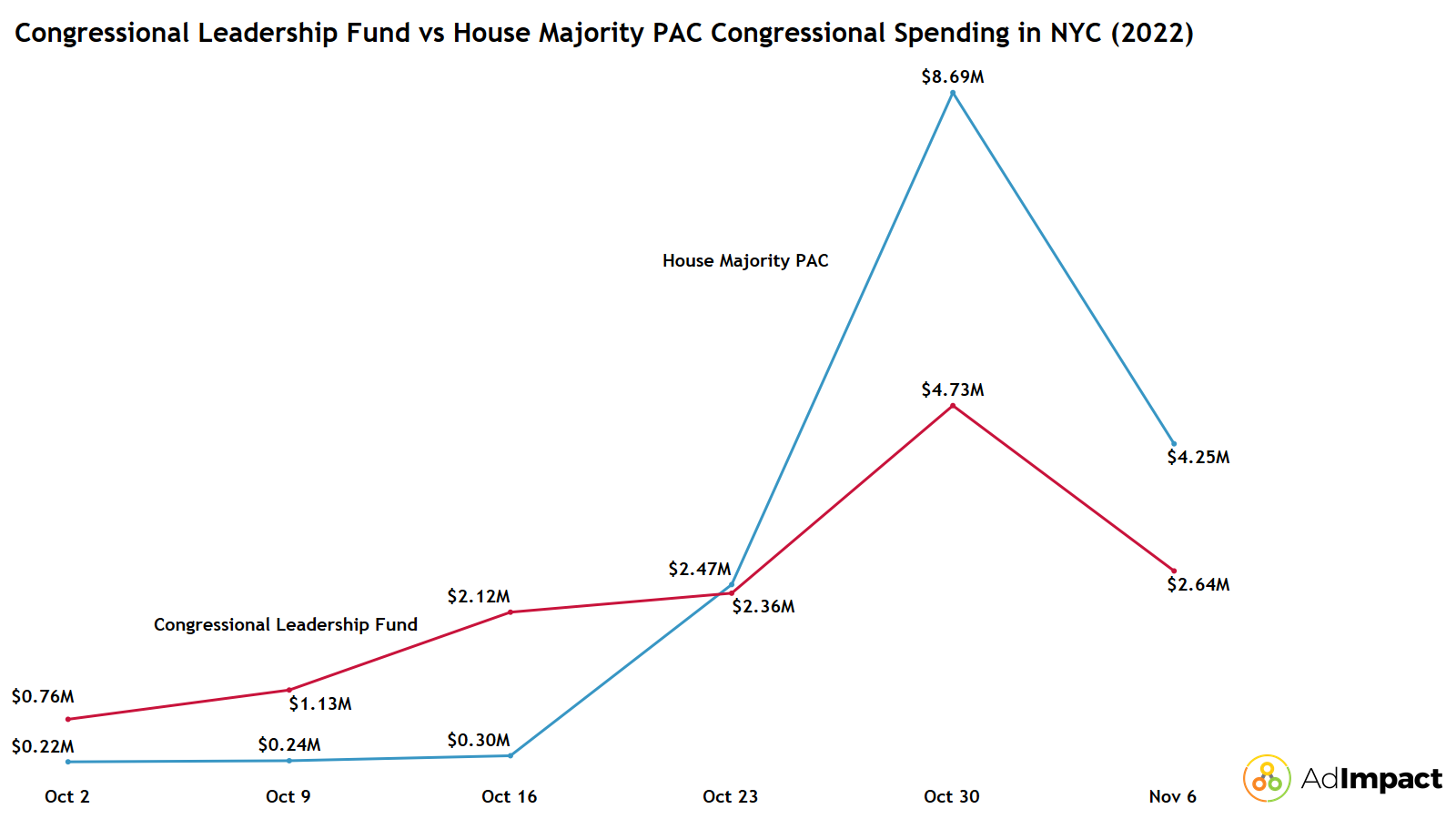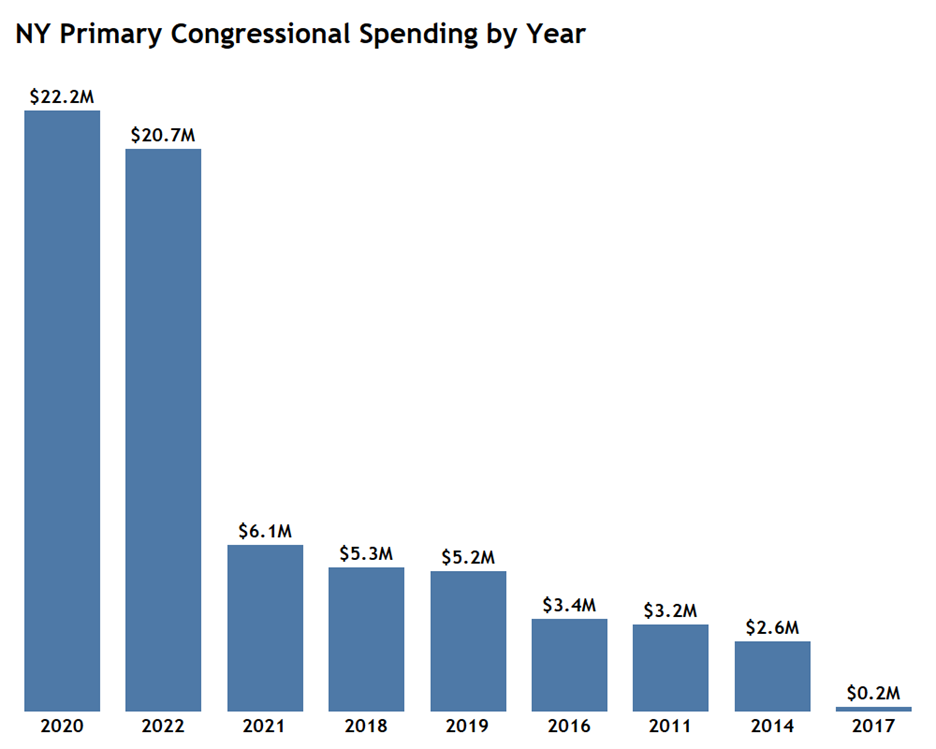Written by Meaghan Walsh
With Republicans officially winning narrow control of the House after the 2022 midterms, we wanted to revisit one of the most important states for the GOP in securing federal power, New York. This midterm cycle, Republicans earned a major victory in the Empire State by flipping 4 seats. We previously covered the competitive NY primary process that was largely defined by redistricting from the 2020 Census due to the loss of 1 House seat in the state. As you will see in this political spending analysis, redistricting continued to have an oversized effect on the general election this year. To better understand the results, we will look at this congressional spending deep dive, including messaging trends and analyze the nearly $80M in overall spending within the most competitive general elections this year in NYS as identified by the non-partisan Cook Political Report.
There were 10 congressional races in NY that the Cook Political Report ranked on a scale from Likely Republican to Likely Democrat. According to their analysis, NY CD-02 and NY CD-11 were likely Republican; NY CD-01 was Lean Republican; and NY CD-22 was Republican Toss Up. On the Democratic side, NY CD-03, NY CD-04, NY CD-17, and NY CD-19 were categorized as Democratic Toss Up; NY CD-18 was Lean Democrat; and NY CD-25 was Likely Democrat.

In a stunning turn for a state that was previously assumed to be nearly solid blue, Republicans flipped every Democratic Toss Up race, and held their Republican Toss Up, Lean Republican, and Likely Republican races for a total of 8 seats. Democrats were only able to keep 2 seats overall–their Lean and Likely Democratic contests. In other words, Democrats were only able to secure their safest seats, whereas Republicans both flipped and held seats to gain a large majority within these competitive elections.
For both parties, redistricting fights were at the center of this year’s midterms. Under new maps, a clear battleground emerged, and spending funneled towards Democratic Toss Up races to the tune of $43M. In perhaps the clearest example of Democratic struggles after redistricting, DCCC chairman Sean Patrick Maloney strategically ran in NY CD-17 after electoral changes, moving incumbent Mondaire Jones to NY CD-10. However, now Maloney is the first DCCC chair to lose re-election in more than 40 years. NY CD-17 was 1 of the 4 Democratic Toss Up elections in NY. For Democratic Toss Ups, the most competitive election was NY CD-19 at $18M, then NY CD-17 at $15M, followed by $5M in NY CD-04, and $4M in NY CD-03. The next most expensive categories were the Republican Toss Up election in NY CD-22 at $16M and the Lean Democrat election in NY CD-18 at $13M.

Overall, Democrats had spending advantages over Republicans in these competitive races, dropping $45M to the Republicans $34M total. In 4 of the 6 race rating categories, Democrats outspent their GOP counterparts. The largest spending advantage for Democrats was in the Likely Democrat category, where they spent $1.3M to the Republicans $0.3M. For Republicans, their largest spending advantage was in the Republican Toss Up category with $8.1M spent to the Democratic $7.7M.
When looking at the messaging for these races by airings, the top 3 messages that emerged were abortion, crime, and inflation. In these competitive races, Democrats centered their messaging around access to abortion after the overturn of Roe v. Wade by the Supreme Court. On the other hand, Republicans focused on crime rates and rising inflation in New York. When Democrats ventured into discussing crime and inflation, they called Republican attack ads “false” and “lies” and reiterated their support of the economy and police.

While these races were competitive throughout the general election cycle, there was a pattern of late stage “bailouts” by key stakeholders. Poor polling numbers, especially statewide, spooked a lot of political insiders into investing large amounts within New York in the final days before the election. Notably, President Joe Biden and First Lady Jill Biden campaigned for Democrats throughout New York State leading up to November 8th. The Democratic group House Majority PAC also invested $275K on broadcast in NY CD-25 a week before the election to help secure a seemingly safe seat in Rochester.
Looking at spending over time in each category, we can see a huge spike in spending in Democratic Toss Up and Lean Democrat elections right before the final bell. Republican Toss Up races also had a steady increase in the final weeks. However, Likely Republican, Likely Democrat, and Lean Republican races all remained relatively consistent throughout the election cycle and did not get nearly as much investment as the more competitive races.

In conjunction with continued national support there was also an influx of support that came through heavily in the New York City markets the week before the election. Following October 30th, we saw the Democratic issue group House Majority PAC spend $8.69M in NYC, compared to the $4.73M spent by the Republican group the Congressional Leadership Fund. The New York market reaches far beyond just the 5 boroughs, touching 19 congressional districts in New York State alone. These groups used the expansiveness of this market to their advantage in the final push, spending in NY CD-03, NY CD-04, NY CD-17, and NY CD-18 on broadcast.

During the general election season, issue groups had a real impact in competitive New York house races. Looking at the top 5 issue group spenders, we can see the Republicans placing $25M between the Congressional Leadership Fund at $20M and NRCC with $5M. On the Democratic side, the top outside groups spent $26M altogether, $15M for House Majority PAC, $6M by the DCCC, and $5M by Vote Vets.

Overall, spending hit nearly $80M on political advertisements in New York State during the general election season in competitive House races. Both Republicans and Democrats demonstrated consistent messaging patterns during this time. While both parties spent millions on these races, especially at the 11th hour, Democrats consistently outspent Republicans. However, Democrats would eventually lose 4 seats and a leadership member to the GOP. Time will tell whether Democrats will consistently struggle under these new geographic conditions. Going forward, AdImpact will continue to offer congressional spending deep dives and monitor patterns in the Empire State to better understand the political landscape.



